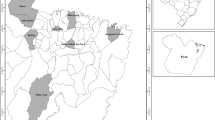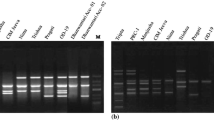Abstract
Litchi (Litchi chinensis Sonn.) is a fruit crop with a clear niche for expansion in countries with subtropical climates. One of the main limitations for breeding purposes and optimum germplasm management in this species is the confusion in cultivar denomination among different producing countries and germplasm collections worldwide. Litchi cultivar identification is still mainly based on morphological characters, and homonymies and synonymies are very frequent. To address this gap, a molecular study was conducted to characterize litchi accessions from two of the main litchi-producing regions for the export market, Mauritius and Réunion, and to compare them to those obtained from litchi cultivars from different origins conserved in a germplasm collection in Spain. Eleven simple sequence repeat (SSR) loci were used to characterize molecular polymorphisms among 88 litchi accessions conserved in Mauritius, Réunion, and Spain. A total of 67 amplification fragments were detected with those 11 SSRs, with an average of 6.1 bands/SSR. Three primer pairs seemed to amplify more than one locus. The mean expected and observed heterozygosities over the eight single locus SSRs averaged 0.53 and 0.61, respectively. The total value for the probability of identity was 9.78 × 10−4. Molecular characterization revealed the existence of 42 different genetic profiles. Several synonymies and homonymies in litchi cultivar nomenclature both within and across geographical regions were found. This comparative study provides the basis for the standardization of litchi cultivar nomenclature over the studied regions and in other litchi-producing countries.

Similar content being viewed by others
References
Anuntalabhochai R, Chundet R, Chiangda J, Apavatjrut P (2002) Genetic diversity within lychee based on RAPD analysis. Acta Hort 575:253–259
Aradhya MK, Zee FT, Manshardt RM (1995) Isozyme variation in lychee (Litchi chinensis Sonn). Sci Hort 63:21–35
Degani C, Beiles A, El-Bastri R, Goren M, Gazit S (1995) Identifying lychee cultivars by isozyme analysis. J Am Soc Hort Sci 120:307–312
Degani C, Deng J, Beiles A, El-Batsri R, Goren M, Gazit S (2003) Identifying lychee cultivars and their genetic relationships using intersimple sequence repeat markers. J Am Soc Hort Sci 128:838–845
Fan Q, Chen SF, Zhou RC, Xiang X, Liao WB, Shi SH (2011) Genetic variation of wild litchi (Litchi chinensis Sonn. subsp. chinensis) revealed by microsatellites. Conserv Genet 12:753–760
Galan Sauco V (1989). Litchi cultivation. FAO Plant Production and Protection Paper No 83. Rome
Ghosh B, Mitra SK, Sanyal D (2001) Litchi cultivars of West Bengal, India. Acta Hort 558:107–114
Goren M, Tomer E, Gazit S (2001) Litchi cultivars in Israel. Acta Hort 558:129–136
Huang X, Zeng L, Huang HB (2005) Lychee and longan production in China. Acta Hort 665:27–36
Liu C, Mei M (2005) Classification of lychee cultivars with RAPD analysis. Acta Hort 665:149–160
Madhou M, Bahorun T, Hormaza JI (2010) Phenotypic and molecular diversity of litchi cultivars in Mauritius. Fruits 65:141–152
McConchie CA, Vithanage V, Batten DJ (1994) Intergeneric hybridization between litchi (Litchi chinensis, Sonn.) and longan (Dimocarpus longan Lour.). Ann Bot 74:111–118
Menzel CM, Simpson DR (1986) Description and performance of major lychee cultivars in subtropical Queensland. Qld Agric J 112:125–136
Menzel CM, Simpson DR (1990) A description of lychee cultivars. Fruit Var J 45:45–56
Menzel CM, Simpson DR (1991) Effects of temperature and leaf water stress on panicle and flower development of litchi (Litchi chinensis Sonn.). J Hort Sci 66:335–344
Menzel CM, Huang X, Liu C (2005) Cultivars and plant improvement. In: Menzel CM, Waite GK (eds) Litchi and longan. Botany, production and uses. CAB International, Wallingford, UK, pp 59–86
Nei M (1973) Analysis of gene diversity in subdivided populations. Proc Natl Acad Sci USA 70:3321–3323
Nei M, Li WH (1979) Mathematical model for studying genetic variation in terms of restriction endonucleases. Proc Natl Acad Sci USA 76:5269–5273
Normand F (1990). Compte rendu de la prospection locale de litchis 1988. LI-RE No 38, IRFA-Réunion, 8p., internal document, ARC 20-002
Normand F, Bouffin J (1994) Management of litchi genetic resources in Réunion. Fruits 49:376–382
Paetkau D, Calvert W, Stirling I, Strobeck C (1995) Microsatellite analysis of population structure in Canadian polar bears. Mol Ecol 4:347–354
Pomology Research Institute (1997) Litchi Pictorial Narration Of Cultivation (Ed. Zhanwei Zhang). Guandong Academy of Agricultural Sciences, China
Pritchard JK, Stephens M, Donnelly P (2000) Inference of population structure using multilocus genotype data. Genetics 155:945–959
Rakoczy-Trojanowska M, Bolibok H (2004) Characteristics and a comparison of three classes of microsatellite-based markers and their application in plants. Cell Mol Biol Lett 9:221–228
Sarin NB, Prasad US, Kumar M, Jain SM (2009) Litchi breeding for genetic improvement. In: Jain S.M. and Priyadarshan P.M. (Eds.). Breeding Plantation Tree Crops: Tropical Species. Springer, pp. 217-245
Viruel MA, Hormaza JI (2004) Development, characterization and variability analysis of microsatellites in lychee. Theor Appl Genet 108:896–902
Van de Peer Y, De Wachter R (1994) TREECON for Windows; a software package for the construction and drawing of evolutionary trees for the Microsoft Windows Environment. Comp Appl Biosci 10:569–570
Watson BJ, Menzel CM, Jordan AT (1988) Lychees: Cultivar names. Farm Note Qld Dept Prim Indust F44
Wright S (1951) The genetical structure of populations. Ann Eugenics 15:323–354
Acknowledgements
Financial support for this work was provided by the Spanish Ministry of Science and Innovation–European Regional Development Fund (Project Grant AGL2010-15140). We thank Yolanda Verdún for the technical assistance.
Author information
Authors and Affiliations
Corresponding author
Additional information
Communicated by A. Kremer
Rights and permissions
About this article
Cite this article
Madhou, M., Normand, F., Bahorun, T. et al. Fingerprinting and analysis of genetic diversity of litchi (Litchi chinensis Sonn.) accessions from different germplasm collections using microsatellite markers. Tree Genetics & Genomes 9, 387–396 (2013). https://doi.org/10.1007/s11295-012-0560-1
Received:
Revised:
Accepted:
Published:
Issue Date:
DOI: https://doi.org/10.1007/s11295-012-0560-1




